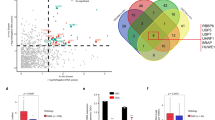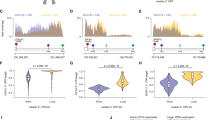Abstract
The role of alternative polyadenylation of mRNA in sustaining aggressive features of tumors is quite well established, as it is responsible for the 3’UTR shortening of oncogenes and subsequent relief from miRNA-mediated repression observed in cancer cells. However, the information regarding the vulnerability of cancer cells to the inhibition of cleavage and polyadenylation (CPA) machinery is very scattered. Only few recent reports show the antitumor activity of pharmacological inhibitors of CPSF3, one among CPA factors. More in general, the fact that deregulated CPA can be seen as a new hallmark of cancer and as a potential reservoir of novel therapeutic targets has never been formalized. Here, to extend our view on the potential of CPA inhibition (CPAi) approaches as anticancer therapies, we systematically tested the fitness of about one thousand cell lines of different cancer types upon depletion of all known CPA factors by interrogating genome-scale CRISPR and RNAi dependency maps of the DepMap project. Our analysis confirmed core and accessory CPA factors as novel vulnerabilities for human cancer, thus highlighting the potential of CPAi as anticancer therapy. Among all, CPSF1 appeared as a promising actionable candidate for drug development, as it showed low dependency scores pancancer and particularly in highly proliferating cells. In a personalized medicine perspective, the observed differential vulnerability of cancer cell lines to selected CPA factors may be used to build up signatures to predict response of individual human tumors to CPAi approaches.
This is a preview of subscription content, access via your institution
Access options
Subscribe to this journal
Receive 12 print issues and online access
$259.00 per year
only $21.58 per issue
Buy this article
- Purchase on Springer Link
- Instant access to full article PDF
Prices may be subject to local taxes which are calculated during checkout


Similar content being viewed by others
References
Shi Y, Giammartino DCD, Taylor D, Sarkeshik A, Rice WJ, Yates JR, et al. Molecular Architecture of the Human Pre-mRNA 3′ Processing Complex. Mol Cell. 2009;33:365–76.
Mitschka S, Mayr C. Context-specific regulation and function of mRNA alternative polyadenylation. Nat Rev Mol Cell Biol. 2022;23:779–96.
Gruber AJ, Zavolan M. Alternative cleavage and polyadenylation in health and disease. Nat Rev Genet. 2019;20:599–614.
Mayr C, Bartel DP. Widespread shortening of 3’UTRs by alternative cleavage and polyadenylation activates oncogenes in cancer cells. Cell. 2009;138:673–84.
He XJ, Zhang Q, Ma LP, Li N, Chang XH, Zhang YJ. Aberrant Alternative Polyadenylation is Responsible for Survivin Up-regulation in Ovarian Cancer. Chin Med J. 2016;129:1140–6.
Cacioppo R, Akman HB, Tuncer T, Erson-Bensan AE, Lindon C. Differential translation of mRNA isoforms underlies oncogenic activation of cell cycle kinase Aurora A. eLife. 2023;12:RP87253.
Lembo A, Cunto FD, Provero P. Shortening of 3′UTRs Correlates with Poor Prognosis in Breast and Lung Cancer. PLOS One. 2012;7:e31129.
Yuan F, Hankey W, Wagner EJ, Li W, Wang Q. Alternative polyadenylation of mRNA and its role in cancer. Genes Dis. 2021;8:61–72.
Ding J, Su Y, Liu Y, Xu Y, Yang D, Wang X, et al. The role of CSTF2 in cancer: from technology to clinical application. Cell Cycle. 2024;0:1–15.
Ning Y, Liu W, Guan X, Xie X, Zhang Y. CPSF3 is a promising prognostic biomarker and predicts recurrence of non-small cell lung cancer. Oncol Lett. 2019;18:2835–44.
Chen W, Guo W, Li M, Shi D, Tian Y, Li Z, et al. Upregulation of Cleavage and Polyadenylation Specific Factor 4 in Lung Adenocarcinoma and Its Critical Role for Cancer Cell Survival and Proliferation. PLOS One. 2013;8:e82728.
Li B, Cai Y, Chen C, Li G, Zhang M, Lu Z, et al. Genetic Variants That Impact Alternative Polyadenylation in Cancer Represent Candidate Causal Risk Loci. Cancer Res. 2023;83:3650–66.
Huang XD, Chen YW, Tian L, Du L, Cheng XC, Lu YX, et al. NUDT21 interacts with NDUFS2 to activate the PI3K/AKT pathway and promotes pancreatic cancer pathogenesis. J Cancer Res Clin Oncol. 2024;150:8.
Xing Y, Chen L, Gu H, Yang C, Zhao J, Chen Z, et al. Downregulation of NUDT21 contributes to cervical cancer progression through alternative polyadenylation. Oncogene. 2021;40:2051–64.
Cui Y, Wang L, Ding Q, Shin J, Cassel J, Liu Q, et al. Elevated pre-mRNA 3′ end processing activity in cancer cells renders vulnerability to inhibition of cleavage and polyadenylation. Nat Commun. 2023;14:4480.
Ross NT, Lohmann F, Carbonneau S, Fazal A, Weihofen WA, Gleim S, et al. CPSF3-dependent pre-mRNA processing as a druggable node in AML and Ewing’s sarcoma. Nat Chem Biol. 2020;16:50–9.
Author Correction: CPSF3-dependent pre-mRNA processing as a druggable node in AML and Ewing’s sarcoma. Nat Chem Biol. Available from: https://www.nature.com/articles/s41589-020-0508-y
Liu L, Yu AM, Wang X, Soles LV, Teng X, Chen Y, et al. The anticancer compound JTE-607 reveals hidden sequence specificity of the mRNA 3’ processing machinery. Nat Struct Mol Biol. 2023;30:1947–57.
Shen P, Ye K, Xiang H, Zhang Z, He Q, Zhang X, et al. Therapeutic targeting of CPSF3-dependent transcriptional termination in ovarian cancer. Sci Adv. 2023;9:eadj0123.
Behan FM, Iorio F, Picco G, Gonçalves E, Beaver CM, Migliardi G, et al. Prioritization of cancer therapeutic targets using CRISPR–Cas9 screens. Nature. 2019;568:511–6.
Tsherniak A, Vazquez F, Montgomery PG, Weir BA, Kryukov G, Cowley GS, et al. Defining a Cancer Dependency Map. Cell. 2017;170:564–576.e16.
Barretina J, Caponigro G, Stransky N, Venkatesan K, Margolin AA, Kim S, et al. The Cancer Cell Line Encyclopedia enables predictive modelling of anticancer drug sensitivity. Nature. 2012;483:603–7.
Cuzick J, Swanson GP, Fisher G, Brothman AR, Berney DM, Reid JE, et al. Prognostic value of an RNA expression signature derived from cell cycle proliferation genes in patients with prostate cancer: a retrospective study. Lancet Oncol. 2011;12:245–55.
Pereira-Castro I, Moreira A. On the function and relevance of alternative 3′-UTRs in gene expression regulation. WIREs RNA. 2021;12:e1653.
Cheng LC, Zheng D, Baljinnyam E, Sun F, Ogami K, Yeung PL, et al. Widespread transcript shortening through alternative polyadenylation in secretory cell differentiation. Nat Commun. 2020;11:3182.
Zhang F, Chen L, Li W, Yang C, Xiong M, Zhou M, et al. Lengthening of 3′ Untranslated Regions of mRNAs by Alternative Polyadenylation Is Associated With Tumor Progression and Poor Prognosis of Clear Cell Renal Cell Carcinoma. Lab Invest. 2023;103:100125.
Dioken DN, Ozgul I, Koksal Bicakci G, Gol K, Can T, Erson-Bensan AE. Differential expression of mRNA 3′-end isoforms in cervical and ovarian cancers. Heliyon. 2023;9:e20035.
Gabel AM, Belleville AE, Thomas JD, McKellar SA, Nicholas TR, Banjo T, et al. Multiplexed screening reveals how cancer-specific alternative polyadenylation shapes tumor growth in vivo. Nat Commun. 2024;15:959.
Weinstein JN, Collisson EA, Mills GB, Shaw KRM, Ozenberger BA, Ellrott K, et al. The Cancer Genome Atlas Pan-Cancer analysis project. Nat Genet. 2013;45:1113–20.
Zhang B, Liu Y, Liu D, Yang L. Targeting cleavage and polyadenylation specific factor 1 via shRNA inhibits cell proliferation in human ovarian cancer. J Biosci. 2017;42:417–25.
di Micco P, Antolin AA, Mitsopoulos C, Villasclaras-Fernandez E, Sanfelice D, Dolciami D, et al. canSAR: update to the cancer translational research and drug discovery knowledgebase. Nucleic Acids Res. 2022;51:D1212–9.
Funding
The research leading to these results has received funding from AIRC under IG 2020 - ID. 24325 – P.I. Gandellini Paolo.
Author information
Authors and Affiliations
Contributions
Giulia Pagani: Investigation, Formal analysis, Visualization, Writing - Original Draft; Paolo Gandellini: Conceptualization, Writing - Review & Editing, Supervision, Project administration, Funding acquisition.
Corresponding author
Ethics declarations
Competing interests
The authors declare no competing interests.
Additional information
Publisher’s note Springer Nature remains neutral with regard to jurisdictional claims in published maps and institutional affiliations.
Supplementary information
Rights and permissions
Springer Nature or its licensor (e.g. a society or other partner) holds exclusive rights to this article under a publishing agreement with the author(s) or other rightsholder(s); author self-archiving of the accepted manuscript version of this article is solely governed by the terms of such publishing agreement and applicable law.
About this article
Cite this article
Pagani, G., Gandellini, P. Cleavage and polyadenylation machinery as a novel targetable vulnerability for human cancer. Cancer Gene Ther (2024). https://doi.org/10.1038/s41417-024-00770-y
Received:
Revised:
Accepted:
Published:
DOI: https://doi.org/10.1038/s41417-024-00770-y



